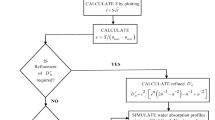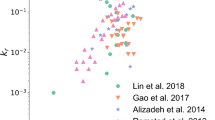Abstract
To successfully predict the performance of building materials exposed to a degradative environment, transport properties must be either measured or estimated. The development of relationships between microstructure and transport properties for these materials should allow accurate prediction of the latter and an increased understanding of how microstructure influences transport. Here, two microstructural characterization techniques, mercury intrusion porosimetry and scanning electron microscopy, are combined with computer modelling techniques to compute the vapor diffusivity and air permeability of three building materials commonly exposed in building facades, two types of brick and a natural sandstone. In general, the computed values compare favorably to those measured experimentally, thus demonstrating the capability of employing microstructural characterization to predict transport properties.
Résumé
Pour obtenir une prédiction fiable des performances des matériaux de construction exposés à un environnement agressif, leurs propriétés de transport doivent être soit mesurées soit estimées. Le développement de relations entre la microstructure et les propriétés de transport devrait permettre une prédiction exacte de ces dernières et une meilleure compréhension de l’influence de la microstructure sur le transfert. Dans cet article, deux techniques de caractérisation de la microstructure (porosimétrie au mercure et microscopie électronique à balayage) sont combinées avec des techniques de simulation par ordinateur pour calculer la diffusivité à la vapeur d’eau et la perméabilité à l’air de trois matériaux de construction traditionnellement utilisés en facades: deux types de brique et un grès naturel. En général, les valeurs calculées sont proches de celles mesurées expérimentalement. Ces résultats démontrent les possibilités des outils de caractérisation de la structure pour prédire les propriétés de transport.
Similar content being viewed by others
References
Kiessl, K., Krus, M. and Künzel, H.M., ‘Weiterentwickelte Mess- und Rechenansätze zur Feuchtebeurteilung von Bauteilen’,Bauphysik 15 H.2 (1993) 61–67.
DIN 52 615: Bestimmung der Wasserdampf-durchlässigkeit von Bau- und Dämmstoffen, 1987.
Struble, L., Stutzman, P.E., ‘Epoxy impregnation of hardened cement for microstructural characterization’,Journal of Materials Science Letters 8 (1989) 632–634.
Castleman, K., Digital Image Processing, (Prentice-Hall, Inc., Englewood Cliffs, NJ, 1979).
Bentz, D.P. and Martys, N.S., ‘Hydraulic radius and transport in reconstructed model three-dimensional porous media’,Transport in Porous Media 17 (3) (1995) 221–238.
Pimentia, P.J.P., Carter, W.C. and Garboczi, E.J., ‘Cellular automaton algorithm for surface mass transport due to curvature gradients: Simulations of sintering’,Computational Materials Science 1 (1992) 630–37.
Berryman, J. G., ‘Measurement of spatial correlation functions using image processing techniques’,Journal of Applied Physics 57 (7) (1985) 2374–2384.
Law, A.M. and Kelton, W.D., ‘Simulation Modeling and Analysis’ (Mc Graw-Hill, New York, 1982).
Stauffer, D., ‘Introduction to Percolation Theory’ (Taylor and Francis, London, 1985).
Garboczi, E.J. and Bentz, D.P., ‘Computer simulation of the diffusivity of cement-based materials’,Journal of Materials Science 27 (1992) 2083–92.
Bentz, D.P., Garboczi, E.J. and Martys, N.S., ‘Application of digital-image-based models to microstructure, transport properties, and degradation of cement-based materials’, in ‘The Modeling of Microstructure and Its Potential for Studying Transport Properties and Durability’, Eds. H.M. Jenningset al., (Kluwer Academic Publishers, 1996) 167–186.
Holman, J.P., ‘Heat Transfer’ (McGraw-Hill, New York, 1981).
Martys, N.S. and Garboczi, E.J., ‘Length scales relating the fluid permeability and electrical conductivity in random two-dimensional model porous media’,Phys. Rev. B 46 (1992) 6080–88.
Schwartz, L.M., Martys, N.S., Bentz, D.P., Garboczi, E.J. and Torquato, S., ‘Cross property pelations and permeability estimation in model porous media’,Phys. Rev. E. 48 (1993) 4584–91.
Daian, J.F., Xu, K. and Quenard, D., ‘Invasion and transport processes in multiscale model structures for porous media’, COPS III, IUPAC Symp. on the Characterization of Porous Solids, Marseille, 1993.
Daian, J.F., Xu, K. and Quenard, D., ‘Multiscale models: A tool to describe the porosity of cement-based materials and to predict their transport properties’, in ‘The Modeling of Microstructure and Its Potential for Studying Transport Properties and Durability’, Eds. H.M. Jenningset al. (Kluwer Academic Publishers, 1996) 107–136.
Xu, K., “Structures multichelles: Modèles pour la Description des Matériaux Poreux et l’Estimation de leurs Propriétés de Transport’, Ph.D Thesis, Université Joseph Fourier-Grenoble I, 1995.
King, P.R., ‘The use of renormalization for calculating effective permeability’,Transport in Porous Media 4 (1) (1989) 37–58.
Katz, A.J. and Thompson, A.H.,Journal of Geophysical Research 92 (B1) (1987) 599 andPhys. Rev. B 34 (1986) 8179.
Author information
Authors and Affiliations
Additional information
Editorial note: Mr. Daniel Quenard is a RILEM Senior Member and a member of TC 123-MME on the Use of Microstructural Models and Expert systems for Cemenitious Materials. He and Mr. K. Xu work at the CSTB (Centre Scientifique et Technique du Bâtiment), France, a RILEM Titular Member. Mr. Dale P. Bentz is a RILEM Senior Member and participates in the work of TC 159-ETC (Engineering of the Interfacial Transition Zone in Cementitious Composites). He and Mr. Nicos Martys work at the National Institute of Standards and Technology (NIST), USA, a RILEM Titular Member.
Rights and permissions
About this article
Cite this article
Quenard, D.A., Xu, K., Künzel, H.M. et al. Microstructure and transport properties of porous building materials. Mat. Struct. 31, 317–324 (1998). https://doi.org/10.1007/BF02480673
Received:
Accepted:
Issue Date:
DOI: https://doi.org/10.1007/BF02480673




